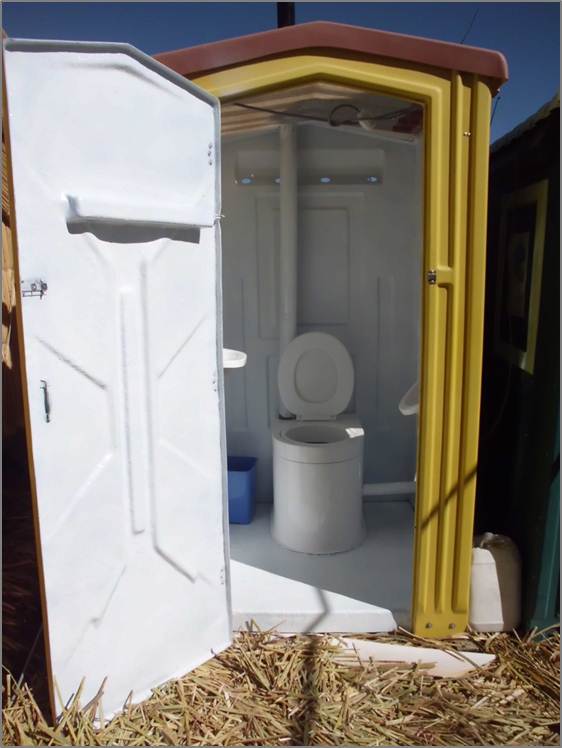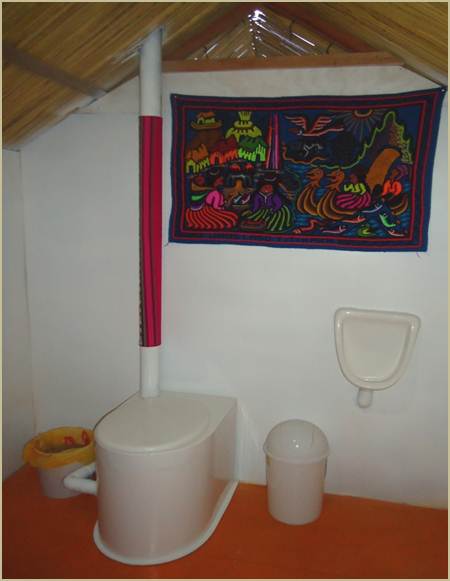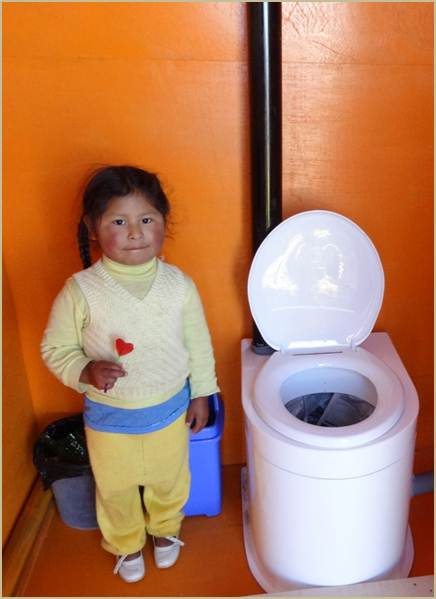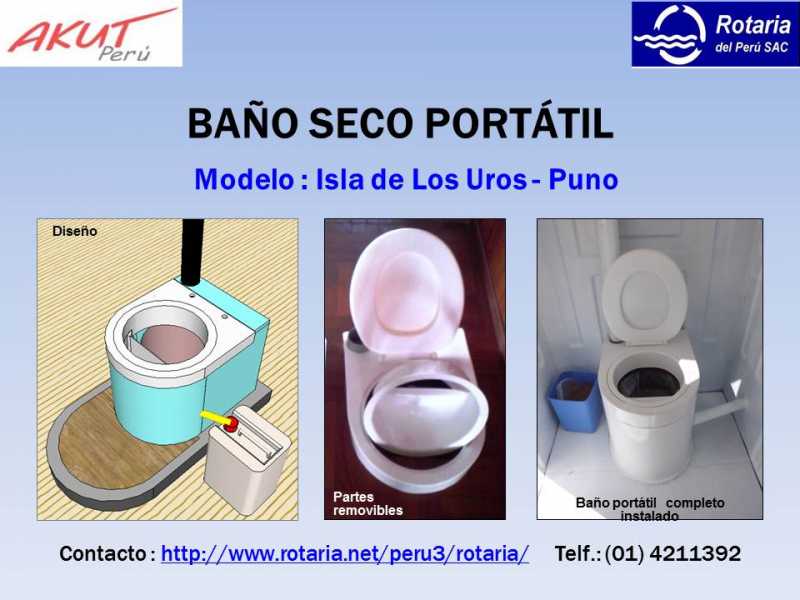- Sanitation systems
- Toilets with urine diversion
- UDDTs (urine-diverting dry toilets)
- Portable UDDT – used in floating islands with vermicompost - Lake Titicaca, Peru
Portable UDDT – used in floating islands with vermicompost - Lake Titicaca, Peru
9569 views
Re: Portable UDDT – used in floating islands with vermicompost
Dear David,
just some quick answers (which will not be very helpful).
The project was a strict commercial project... no aid money, therefore no money to follow up, accompanying or something like that. We did some follow up on our own.
Sorry – we would love to do more about the total project or to roll it out, but we had no funding.
Regards
Christoph
just some quick answers (which will not be very helpful).
The project was a strict commercial project... no aid money, therefore no money to follow up, accompanying or something like that. We did some follow up on our own.
Each household was responsible (we are talking about 10 households)- What is the responsibility of the household for the treatment process?
We did not a specific (controlled) pathogen removal, just a composting process in a box – main aim was more to reduce volume in order to reduce transport necessities.- What kind of pathogen treatment are you using and how efficient are they?
As described in the manual there is a whole range of cover materials – we do prefer saw dust. We did not provide the material as operation was not our task.- What sources of cover material have you used and how do you provide it to the users.
Sorry – we would love to do more about the total project or to roll it out, but we had no funding.
Regards
Christoph
Please Log in to join the conversation.
You need to login to reply- davidpereira
-
- Sanitation for all
Less- Posts: 6
- Likes received: 1
Re: Portable UDDT – used in floating islands with vermicompost
Helo Chirstoph,
I'm also working with a UDDT prototype in Ecuador, and I'm very interested in the project you have shared.
It seems to be a good sanitation solution, and its good to know that you are making some different treatments for the feces and urine. About that, how does it works the process of collecting 30 L of humanure on each place and take it to one centralized treatment plant?
Speciffically:
- What is the reponsibility of the household for the treatment process?
- What kind of pathogen treatment are you using and how efficient are they?
- What sources of cover material have you used and how do you provide it to the users?
Thank you for the answer.
You can also see about our toilet at: www.fundacioninterris.org/afichett.pdf *
Regards!
David Pereira
* Or see here on the forum:
forum.susana.org/forum/categories/106-us...on-in-terris-ecuador
(added by moderator)
I'm also working with a UDDT prototype in Ecuador, and I'm very interested in the project you have shared.
It seems to be a good sanitation solution, and its good to know that you are making some different treatments for the feces and urine. About that, how does it works the process of collecting 30 L of humanure on each place and take it to one centralized treatment plant?
Speciffically:
- What is the reponsibility of the household for the treatment process?
- What kind of pathogen treatment are you using and how efficient are they?
- What sources of cover material have you used and how do you provide it to the users?
Thank you for the answer.
You can also see about our toilet at: www.fundacioninterris.org/afichett.pdf *
Regards!
David Pereira
* Or see here on the forum:
forum.susana.org/forum/categories/106-us...on-in-terris-ecuador
(added by moderator)
Please Log in to join the conversation.
You need to login to reply- HarryTams
-
Less
- Posts: 31
- Likes received: 14
Re: Portable UDDT – used in floating islands with vermicompost
Australia has a couple of brands of composting toilets but they they cost $1,500 - 3,000+. The toilet that you are using at $150 each is a gift! Australia is also amongst the world's most regulated country (Red tape, green tape) Australian Standards appears to be used as international trade protection. This pushes costs higher.
Our National Government gave grants to families to reduce water consumption, however, some Local Government Councils would not allow the use of composting/waterless toilets to reduce their water consumption. The water closet (WC) toilet consumes more water than any other domestic water usage. It is for these reasons that we are trying to push the boundaries with the UDDT toilet here.
What you are doing with your portable UDDT is superior to what we are doing in the so called "developed" country. Thank you for your effort in reducing the cost of human waste (Actually valuable resource) treatment/reuse. The technology needs to become mainstream.
Harry Tams
Tasmania
Our National Government gave grants to families to reduce water consumption, however, some Local Government Councils would not allow the use of composting/waterless toilets to reduce their water consumption. The water closet (WC) toilet consumes more water than any other domestic water usage. It is for these reasons that we are trying to push the boundaries with the UDDT toilet here.
What you are doing with your portable UDDT is superior to what we are doing in the so called "developed" country. Thank you for your effort in reducing the cost of human waste (Actually valuable resource) treatment/reuse. The technology needs to become mainstream.
Harry Tams
Tasmania
The following user(s) like this post: KaiMikkel
Please Log in to join the conversation.
You need to login to replyRe: Portable UDDT – used in floating islands with vermicompost
Dear Harry,
I had a look at your video "castle" - very nice. I liked the idea. But in this case I think the bench style with an opening form outside and a bucket should be the best option. I really liked the concept and for sure you are right a UDDT is a perfect combination - but I would do bench - as you did. Seems easier to me. If you want we could send an insert to you to produce it locally. But isn´t that available in Australia as well?
Regards
Christoph
I had a look at your video "castle" - very nice. I liked the idea. But in this case I think the bench style with an opening form outside and a bucket should be the best option. I really liked the concept and for sure you are right a UDDT is a perfect combination - but I would do bench - as you did. Seems easier to me. If you want we could send an insert to you to produce it locally. But isn´t that available in Australia as well?
Regards
Christoph
Please Log in to join the conversation.
You need to login to replyRe: Portable UDDT – used in floating islands with vermicompost
Dear Marijn and Krishan,
Marijn: Once we tried to keep worms in our own UD toilet (with 25 L bucket in the bench), but it was difficult to control, worms are sensitive against Ammonia (NH3) (urine) and a ventilated UD fecal storage tank normally is to dry (worse in case of vaults, more volume, longer retention time --> drier). The other problem is that people could dislike the idea of “visual worm contact” in their toilet, this is not a real argument, because the earthworms will not come to the surface, but it seems that most resistances against UD are not real, but resistant...
Our preferred solution for the Mobil Toilet (transportable 25 buckets or boxes) is an external compost place or boxes, for a single toilet for instance a covered plastic box (> 120 L) with perforations for good ventilation. One of our clients used for composting of UD feces with organic waste some stackable boxes as are used for vegetable transport (the management is a litte bit “intensive” because the boxes are small); in the internet are a lot of ideas for compost on household level. But without any doubts compost process in scale (> 1.000 UD toilets) is better to manage and in this case lombri-compost (to get well degraded humus) normally is the last step, after heat compost.
On household level and cold climate it can be better to use lombri-composting directly. But you are right, it needs additional material or water. In the UD toilet we use normally sawdust.
I hope that clarifies a bit.
Krishan: Sorry I oversaw your comment. a) Mainly tourists b) Is it all fishing & tourism.
Regards
Christoph
Marijn: Once we tried to keep worms in our own UD toilet (with 25 L bucket in the bench), but it was difficult to control, worms are sensitive against Ammonia (NH3) (urine) and a ventilated UD fecal storage tank normally is to dry (worse in case of vaults, more volume, longer retention time --> drier). The other problem is that people could dislike the idea of “visual worm contact” in their toilet, this is not a real argument, because the earthworms will not come to the surface, but it seems that most resistances against UD are not real, but resistant...
Our preferred solution for the Mobil Toilet (transportable 25 buckets or boxes) is an external compost place or boxes, for a single toilet for instance a covered plastic box (> 120 L) with perforations for good ventilation. One of our clients used for composting of UD feces with organic waste some stackable boxes as are used for vegetable transport (the management is a litte bit “intensive” because the boxes are small); in the internet are a lot of ideas for compost on household level. But without any doubts compost process in scale (> 1.000 UD toilets) is better to manage and in this case lombri-compost (to get well degraded humus) normally is the last step, after heat compost.
On household level and cold climate it can be better to use lombri-composting directly. But you are right, it needs additional material or water. In the UD toilet we use normally sawdust.
I hope that clarifies a bit.
Krishan: Sorry I oversaw your comment. a) Mainly tourists b) Is it all fishing & tourism.
Regards
Christoph
The following user(s) like this post: Marijn Zandee, cecile
Please Log in to join the conversation.
You need to login to replyRe: Portable UDDT – used in floating islands with vermicompost
Dear Chris,
Great looking toilets. Could you tell us a bit more about the vermi-composting? Are the worms living in a vault underneath the toilet, or are the feces collected and then moved to a different container for the composting? Also, what covering material do you use in the toilet, and what do you mix in with the dried feces before feeding it to the worms?
I realize some of this may be in the video you posted, but my internet is a bit slow. And unfortunately I cannot read the Spanish language pdf you attached.
Thanks
Marijn
Great looking toilets. Could you tell us a bit more about the vermi-composting? Are the worms living in a vault underneath the toilet, or are the feces collected and then moved to a different container for the composting? Also, what covering material do you use in the toilet, and what do you mix in with the dried feces before feeding it to the worms?
I realize some of this may be in the video you posted, but my internet is a bit slow. And unfortunately I cannot read the Spanish language pdf you attached.
Thanks
Marijn
Marijn Zandee
E: This email address is being protected from spambots. You need JavaScript enabled to view it.
E: This email address is being protected from spambots. You need JavaScript enabled to view it.
The following user(s) like this post: cecile
Please Log in to join the conversation.
You need to login to reply- HarryTams
-
Less
- Posts: 31
- Likes received: 14
Re: Portable UDDT – used in floating islands with vermicompost
We use the bench type in our micro-dwellings. See www.youthfutures.org.au and click on the Castle to see a six minute video of our project. We are using the 'bench'type Dass-Isak Separett UDDT insert from Sweden. This too was not able to be stacked (like buckets fit into each other).
The UDDT from Peru would be ideal for our requirements because the end user can choose what type of toilet they require/desire. Local laws don't allow anything but Water Closet (WC) toilets if the sewer line is at the property in some jurisdictions. As our micro-dwellings are caravans (RV trailers) that fold out to be much larger, weight is an important factor. Another reason the UDDT that you use would be desireable. The cost of shipping to get 10 of the units to Tasmania from Peru would be high. If the products could be stacked like buckets...Well, wouldn't it be good.
Harry
Tasmania
The UDDT from Peru would be ideal for our requirements because the end user can choose what type of toilet they require/desire. Local laws don't allow anything but Water Closet (WC) toilets if the sewer line is at the property in some jurisdictions. As our micro-dwellings are caravans (RV trailers) that fold out to be much larger, weight is an important factor. Another reason the UDDT that you use would be desireable. The cost of shipping to get 10 of the units to Tasmania from Peru would be high. If the products could be stacked like buckets...Well, wouldn't it be good.
Harry
Tasmania
Please Log in to join the conversation.
You need to login to replyRe: Portable UDDT – used in floating islands with vermicompost
Dear Harry nice to meet you,
first or all thanks for your interest. Could you give us a little bit of background on you? Your observation is on one hand very clear and I agree (solution to be stacked) and I will answer that below, but what made me wonder is your comment about the urinal. That is a quite common approach for UDDT. Personally I do prefer very much bench style systems (you can see a lot in this video in the first 8 minutes).
I don´t know what application you have in mind, but if it is for a house … why doing a container solution? Beside that the solution in the video and the portable solution are the same.
Concerning your observation of stack ability – that is VERY tricky, we have thought around that problem a lot already. The pedestal is just too big and it would have to be conic broader at the top – and so on. If you start thinking around that problem you see the problems rapidly.
Therefore basically we think that the best solution would be to produce just the insert (see arrow in the picture below) and put it on a round tube with the right diameter or as I said before do a bench.
I hope that gave some ideas.
By the way, in Lima this portable toilet is about 150 US$.
Regards
Christoph
first or all thanks for your interest. Could you give us a little bit of background on you? Your observation is on one hand very clear and I agree (solution to be stacked) and I will answer that below, but what made me wonder is your comment about the urinal. That is a quite common approach for UDDT. Personally I do prefer very much bench style systems (you can see a lot in this video in the first 8 minutes).
I don´t know what application you have in mind, but if it is for a house … why doing a container solution? Beside that the solution in the video and the portable solution are the same.
Concerning your observation of stack ability – that is VERY tricky, we have thought around that problem a lot already. The pedestal is just too big and it would have to be conic broader at the top – and so on. If you start thinking around that problem you see the problems rapidly.
Therefore basically we think that the best solution would be to produce just the insert (see arrow in the picture below) and put it on a round tube with the right diameter or as I said before do a bench.
I hope that gave some ideas.
By the way, in Lima this portable toilet is about 150 US$.
Regards
Christoph
Attachments:
-
 Bild2.png
(Filesize: 417KB)
Bild2.png
(Filesize: 417KB)
Please Log in to join the conversation.
You need to login to reply- HarryTams
-
Less
- Posts: 31
- Likes received: 14
Re: Portable UDDT – used in floating islands with vermicompost
I've been looking a long time for for a UDDT of this type for our micro-homes here in Tasmania. I like the urinal beside it too. What I find curious is that these designs are developed for the function. I have not found anything that considers the cost of shipping in the design process. It would be so valuable to have a "portable UDDT" that could be stacked or nested together for shipping purposes.
Harry Tams
Youth Futures Inc
Launceston, Tasmania
Harry Tams
Youth Futures Inc
Launceston, Tasmania
Please Log in to join the conversation.
You need to login to replyRe: Portable UDDT – used in floating islands with vermicompost
Seems very nice... this is mainly for the tourists?
Do these floating communities actually practise agriculture on the regular islands, or is it all fishing & tourism?
Do these floating communities actually practise agriculture on the regular islands, or is it all fishing & tourism?
Please Log in to join the conversation.
You need to login to replyPortable UDDT – used in floating islands with vermicompost - Lake Titicaca, Peru
Today I would like to post a project we did last year with the floating islands (isla de los uros) at lake Titicaca (4000 m above sea level).
They had the problem of many tourists coming to the islands who (also) need a bathroom. Often a chemical toilet is used, emptied into the lake at night – a real problem! We were asked to develop a solution and changed our ecolet to a portable 30 l container solution as you can see in the picture below or in the attached manual. As there is a need what to do with the feces, we decided to do a vermicomposting box.
We did about 5 toilets but there is still a lot of room for more. But it might be an interesting option as well for other situations.
Enjoy the pictures of the manual. Even if you don’t speak Spanish the pictures talk for themselves.
Yours
Christoph
P.S. Elisabeth, the pictures apear always to large, eventhough they are small. What can I do. You already told me but I can´t find it. Sorry.
They had the problem of many tourists coming to the islands who (also) need a bathroom. Often a chemical toilet is used, emptied into the lake at night – a real problem! We were asked to develop a solution and changed our ecolet to a portable 30 l container solution as you can see in the picture below or in the attached manual. As there is a need what to do with the feces, we decided to do a vermicomposting box.
We did about 5 toilets but there is still a lot of room for more. But it might be an interesting option as well for other situations.
Enjoy the pictures of the manual. Even if you don’t speak Spanish the pictures talk for themselves.
Yours
Christoph
P.S. Elisabeth, the pictures apear always to large, eventhough they are small. What can I do. You already told me but I can´t find it. Sorry.
This attachment is hidden for guests.
Please log in or register to see it.
Please log in or register to see it.
Attachments:
-
 floatingtoilet.jpg
(Filesize: 45KB)
floatingtoilet.jpg
(Filesize: 45KB)
-
 floatingto...rior.jpg
(Filesize: 24KB)
floatingto...rior.jpg
(Filesize: 24KB)
-
 floatingto...hild.jpg
(Filesize: 28KB)
floatingto...hild.jpg
(Filesize: 28KB)
-
 BanoSecoPo...rSAC.jpg
(Filesize: 47KB)
BanoSecoPo...rSAC.jpg
(Filesize: 47KB)
The following user(s) like this post: canaday, Marijn Zandee, cecile, JKMakowka, KaiMikkel
Please Log in to join the conversation.
You need to login to reply
Share this thread:
- Sanitation systems
- Toilets with urine diversion
- UDDTs (urine-diverting dry toilets)
- Portable UDDT – used in floating islands with vermicompost - Lake Titicaca, Peru
Recently active users. Who else has been active?
Time to create page: 0.451 seconds








